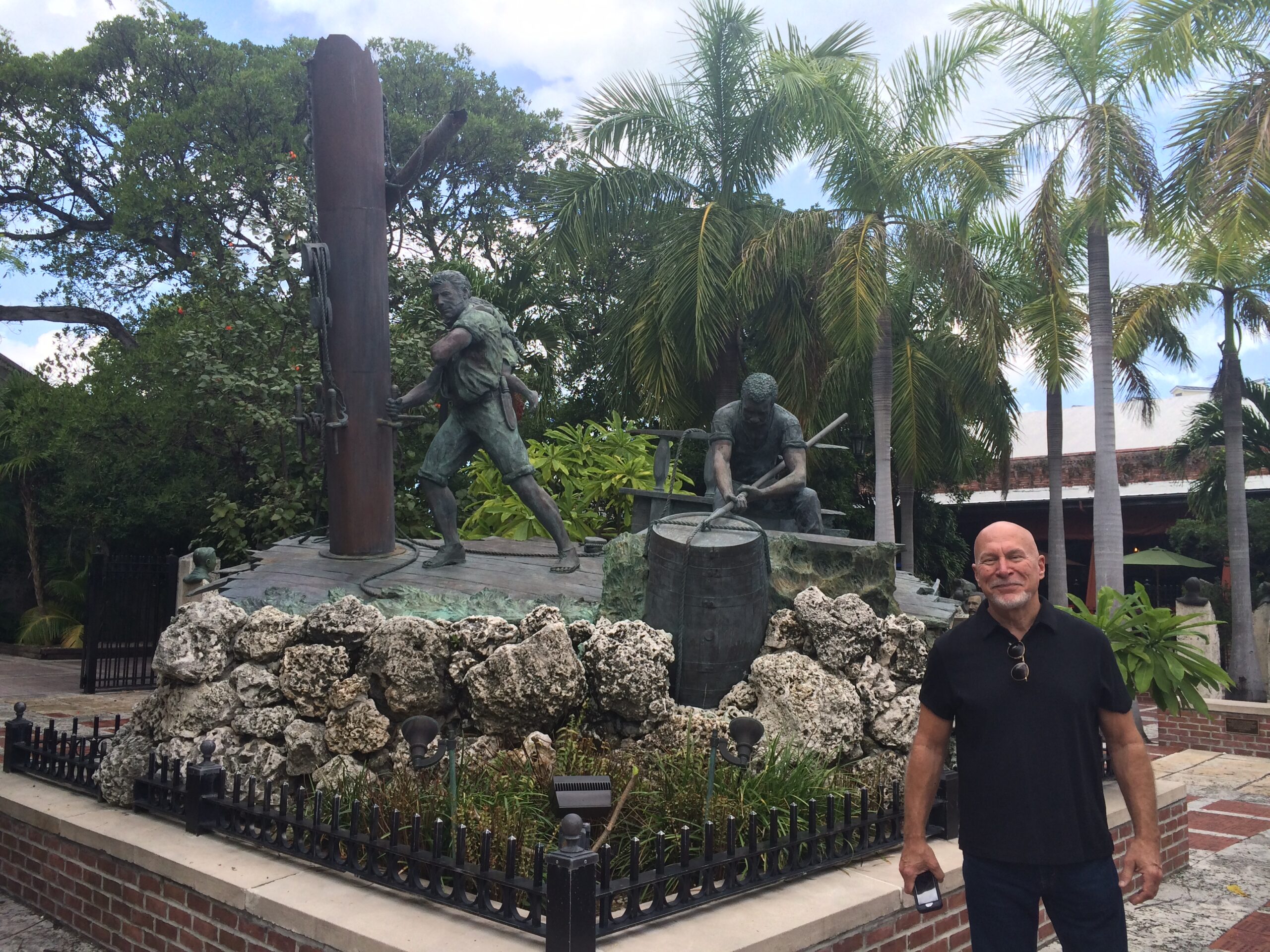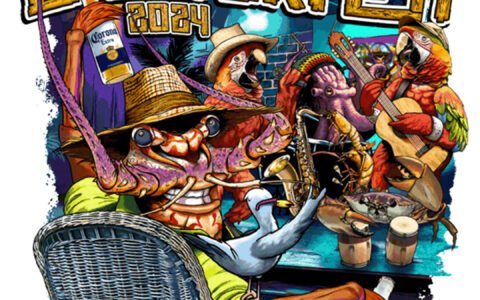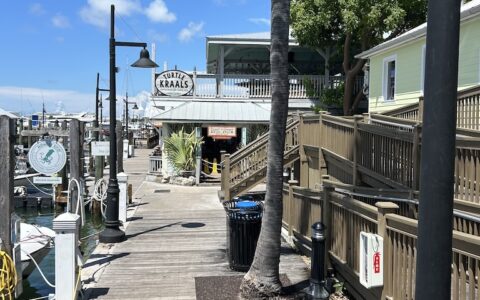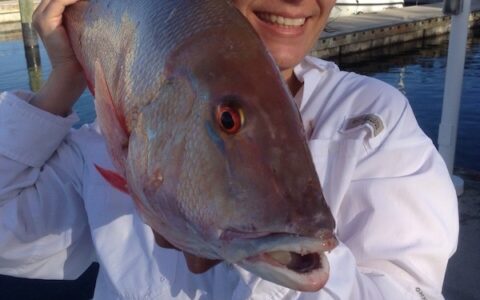In front of the Waterfront Playhouse in Mallory Square is a sculpture garden, opened in September 1997. It originally featured thirty-six bronze busts of people that have had a huge impact on our island city of Key West. A few more faces have been added to the mix in more recent years. Currently, there are 39 busts. These particular people were chosen to be immortalized in the garden due to their talent, ideas and innovations which helped to shape the island, making lasting impacts both seen and unseen. The artist, James Mastin, also created the Loyalist memorial Sculpture Garden in our Sister City of Green Turtle Cay, Bahamas. Below, you will find a list of the people memorialized in the sculpture garden with a brief bio.
In addition to the busts, you will also see a huge statue erected in honor of the wreckers. These wreckers once made our island of Key West the richest city in the country. “The Wreckers,” at 18 feet long and 25 feet high, depict these men saving lives and cargo from a vessel shipwrecked on our reef. The monument was created by sculptor James Mastin of Miami, Florida.
The Garden is open from 7:30am to 9:00pm everyday. The admission is free! Just walk through the gate and enjoy!

Key West Memorial Sculpture Garden Busts
A. Maitland Adams – Adams served as mayor of Key West, city commissioner and county commissioner. From 1914 to 1968, and also worked for Thompson Enterprises Inc., one of the largest employers on the island at one time, where he served as vice president and general manager.
John Bartlum – A shipbuilder and wrecking captain that moved to Key West in 1845. After a devastating hurricane, he returned to his home on Green Turtle Cay. He dismantled his home and brought it back to Key West by schooner. He reassembled it and it still stands at the corner of Eaton and William Streets today.
Livingston Bethel – Born in Nassau, Bahamas, his family relocated to Key West in 1847. He attended school in Key West before leaving to study law. When he returned to Key West he served as the city’s mayor from 1877 until 1880. Bethel also served at Lieutenant Governor, District Attorney, and Criminal Court Judge.
Jefferson Browne – Born in 1857 in Key West. Throughout his life, he worked as a lighthouse keeper, a county surveyor, a city attorney and a postmaster. Browne also served as the president of the Florida State Senate, a Chief Justice of the Florida Supreme Court, and from 1893-1897 he was collector of the port of Key West. He also authored the book, “Key West: The Old and the New”.
Carlos Cespedes – Cuban born, Cespedes moved to Key West after his father worked to liberate the country. He served as president of the Revolutionary Club of Key West. In 1876, he was elected Mayor of Key West, helping to build bridges between the Cuban and American communities on the island.
Sandy Cornish – A former slave that bought his freedom. He bought a farm in Key West and through selling fruits and vegetables became one of the wealthiest people on the island. Cornish became a leader of the local black community. And, he founded the Cornish Chapel of the African Methodist Episcopal Church which still stands at 702 Whitehead Street.
William Curry – Florida’s first millionaire, he came to Key West from the Bahamas at the age of 16 in 1837. Like many, he was looking for better economic opportunities. He was a shipbuilder, a wrecker, and a merchant, amassing a fortune over a career of forty years. And, legend has it that it was in his kitchen that the first Key Lime Pie was invented.
Nelson Francis de Sales English – Born in St. Augustine, Florida, he moved to Key West as a child. In 1882, at the age of 33, he was appointed Postmaster of Key West. That made him not only the youngest person, but also the first black person named to that post. At the end of his term he was named Assistant Postmaster. He worked in the Post Office for more than 20 years as well as at the United States Custom House.
Henry Flagler – While Flagler never lived in Key West, he is responsible for making the island more accessible. He had his railroad extend all the way to Key West, most of it over the water. In 1912, the ambitious Overseas Railroad was completed. And although he did not live to see it, Flagler was also responsible for the building of the Casa Marina.
Sister Louis Gabriel – Sister Gabriel arrived in Key West in 1897. A new nun, she came to teach at the first Catholic School in Florida. She lived through three harrowing hurricanes in 1909, 1910 and 1919. In 1922, she had the Grotto to Our Lady of Lourdes built. Students collected coral rocks from around the island to build it. She told the students to pray at the grotto before a storm and Key West will be saved from complete devastation. You can visit the grotto at St. Mary’s Star of the Sea Basilica.
Eduardo Gato – A Cuban immigrant that became a successful cigar maker and merchant. He is responsible for the creation of Gatoville, a small “city” of forty cottages surrounding his cigar factory to benefit his workers. Gato also started Key West’s first street car system.
Capt. John Geiger – A maritime pilot that became one of the wealthiest men in Key West thanks to his involvement in the wrecking industry. He had what is now known as the Audubon House built for him. The property, originally comprising nearly six acres of land, also housed his slaves. These slaves were lent out to help build Fort Zachary Taylor and Fort Jefferson. Geiger died in his house in 1885.
Margo Golan – Considered to be the greatest philanthropist in Key West, especially towards the local hospital and library. She and her husband built the Key Ambassador and the Holiday Inn hotels, and they helped to modernize the hospitality industry in Key West.
Maria Gutsens – One of a group determined to create a hospital in Key West to help the impoverished. The hospital was opened in 1911. Maria worked there as a nurse until her death in 1941.
Dr. Jeptha Vining Harris – After the Civil War, Harris moved to Key West to become the customs collector; he lived at the Customs House. He also worked as a doctor during this time. And, he served as superintendent of schools in Key West. The Harris School was named for him.
Charles Helberg – A prominent member of the Key West community. He owned and operated the Key Wester Resort Hotel on South Roosevelt Blvd in the 1950s.
Ernest Hemingway – To date, Hemingway is arguably the most famous resident Key West has even had. He is celebrated here yearly during the Hemingway Days festival in July to coincide with his birthday. His house on Whitehead Street can be visited and you can learn much more about this celebrated author.
Lena Johnson – She was the first woman to hold office in Monroe County, serving on the Key West City Commission from 1927-1929. Johnson was also known locally for her baking and candy making skills.
William Kerr – Born in Ireland, Kerr moved to Key West in 1872. He worked as an architect, contractor, and builder. He built his cottage at 410 Simonton Street as well as the Convent of Mary Immaculate in 1878. Kerr also served as the superintendent during the construction of the Customs House and many other notable buildings on the island.
John Lowe Jr – Born in Green Turtle Cay, Lowe came to Key West as a teenager. In Key West, he worked for his brother-in-law, William Curry. He built the now historic house on 620 Southard Street which served as a hospital during WWII.
Ellen Russell Mallory – In 1823, Ellen came to Key West as one of the first women settlers. She served as a nurse during the yellow fever outbreaks in Key West. While Mallory Square is not named for her, she was the mother of Stephen Mallory. He served as a US Senator from 1851 to 1861 and also as Secretary of the Navy during the Civil War.
Stephen Mallory – While Mallory Square is not named for him, this Mallory has a somewhat checkered history. He was a prominent citizen and statesman in the 19th century. But, he was also a slave owner; his slaves were leased out to help build Fort Zachary Taylor and Fort Jefferson.
Judge William Marvin – Born in New York in 1808, he was appointed US Attorney for the Southern District of Florida Territory in 1835. He served at this post until 1839 when he became Judge of the US District Court for the Southern District of Florida Territory. Marvin left the bench in 1845 and began practicing law in Key West. In 1861 he became mayor of Key West, and he served a second term in 1866.
Bernie Papy – Born in Key West in 1902, Papy served in the Florida House of Representatives from 1935 until 1962.
Joe Pearlman – Pearlman immigrated from Romania to Key West in 1904 at the age of 12. He became a leader in the construction industry on the island. Pearlman was also an active member of the Chamber of Commerce, the Key West Rotary, and the Red Cross. In addition, he was the President of the B’nai Zion Synagogue for twenty-five years.
Commodore David Porter – In 1822, the US Navy officially staked claim to Key West when Commodore Porter planted the US flag on the island. 1823, a naval base was established in Key West, and Commodore Porter was given command to suppress piracy in the area. Because of the shallow waters, he utilized an old steam ferryboat to tow barges to cut off the pirates’ escape routes, thus decimating piracy in the Caribbean. However, after going rogue, he was courtmartialed and he left the US to serve in the Mexican Navy.
Dr. Joseph Y Porter – Key West’s first native born doctor who also served as Florida’s first Public Health Officer from 1889 until 1917. He was also instrumental in recognizing that yellow fever was transmitted by mosquitos; he helped to keep the disease under control through specific sanitation and quarantine procedures. The house that he lived and died in, located at 429 Caroline Street, is on the US National Register of Historic Places.
Peter Roberts – A commercial fisherman that ran the retail fish market Curry and Sons for sixty years. He was considered by most to be the best fisherman on the island. He was also in charge of the island’s first aquarium.
Capt Edward Saunders – Part of the “Key West Mob” as Hemingway put it, he was a charter boat captain. He also ran Sloppy Joe’s Bar with Joe Russell and Charles Thompson. Capt. Saunders was the inspiration for Hemingway’s character, Capt. Willie Adams in his Key West novel, “To Have and Have Not”.
John Watson Simonton – Born in New Jersey, Simonton became one of Key West’s first citizens, and an original snow bird. A merchant and businessman that understood the importance the island could play for its harbor, he bought the island from Spaniard Don Juan de Estrata for $2,000 in 1821.
Elisabeth Merklin Knight Beiglett Smith – A German immigrant that was shipwrecked off the coast of Key West. She married her rescuer, Peter Knight. After his death she married twice more, birthing nine children in total who have established some of the leading families in Key West.
John M Spottswood – Born in Key West in 1920, he did much to bring the the island into the future. In 1945 he established the first radio station on the island. And, he is responsible for bringing cable television to the county in 1957. Spottswood was elected sheriff and modernized the department, he also served as a state senator, introducing a bill that created the Florida Keys Community College.
Julius Stone – A chemist, lawyer, and politician. Stone was sent to Key West to lead a relief effort when the once richest city in America went bankrupt. Once he arrived, he decided that the area could benefit from a tourism. Under his direction, beaches were cleaned, buildings were refurbished, and landscaping was added to make the area more appealing. Obviously, his efforts worked!
Norberg Thompson – Thompson was responsible for shaping much of the island’s early 20th century economy. Thompson Enterprises, Inc engaged in fishing, ice production, cigar box manufacturing, trucking, pineapple and guava canning, turtle soup production, sponging, and hardware sales. He even owned most of the Historic Seaport at one time. Thompson provided thousands of jobs to the locals over his 50 years in business.
Asa Tift – Owner of a large salvaging operation in Key West in the early part of the 19th century. He was also the original owner of the famed Hemingway House on Whitehead Street. Check out the Key West Shipwreck Historeum for more history on Asa Tift and the wreckers.
Charley Toppino – An Italian immigrant, he learned the construction trade while helping to build the New York Tunnel Extension. Charley moved to Key West in the 1930’s when he heard about the need for skilled workers to build bridges and roads in the Florida Keys. His Charley Toppino & Sons, Inc has been a major player in Keys construction projects ever since.
Harry Truman – While Truman never lived in Key West, he did visit the island 11 times on working vacations during his presidency. The first of these visits came in 1946. These visits solidified the island as a place of military importance. I highly recommend taking the tour at the Harry S Truman Little White House to learn more about his time here and about the history you Key West.
William Whitehead – A New Jersey native that moved to Key West as a young man in 1828. He made a survey of the island in 1829. In 1830, he was appointed the customs collector, a position which he held until he left the island in 1838. Whitehead also served as the town’s mayor, but when the residents refused to pay the occupational tax that he imposed he resigned, prompting his departure.
Tennessee Williams – This Pulitzer Prize winning playwright wrote and lived in Key West for a number of years. He also helped to assimilate the gay community into Key West. The theater at the local college was named for him. You can visit the Tennessee William Museum for a lot more history about this great writer.
More About Key West History
I love my history. So, as you can imagine I write a lot about it. Everything from historic buildings and architecture to the military and everything in between is touched on in this blog! Just click on the HISTORY link for more blog posts. And, of course, you should visit the different historical sites and museums while visiting the island. For a small island of 2 x 4 miles, there is an awful lot of history.
More About Key West Today
For more Key West information about things to do and see, visit our Key West Web Site. And, remember to check out our restaurant reviews as you surely must eat while down here!
Would you like to reserve some activities while you are visiting? I can help you pick the right options for you! Fishing, Snorkeling, Sunset Sails, Dry Tortugas trips, Sandbar excursions, and more!
Island Genn – Key West Concierge




